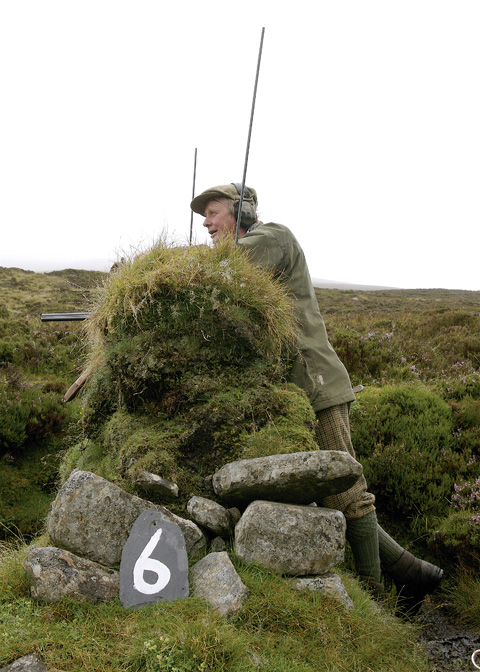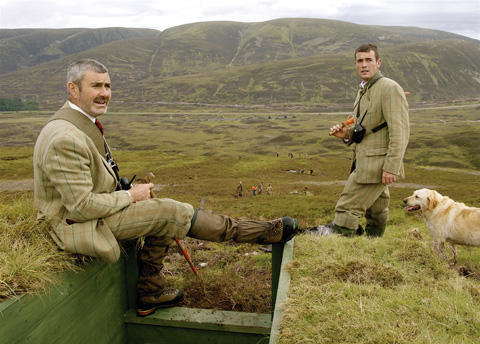Ralia estate: Grouse shooting in Inverness-shire

It’s hard to decide what’s more impressive when leaning against a moss-covered stone butt near the top of A’Mharconaich. Is it the landscape or the birds? Seven more butts form a line down this Scottish Munro, towards the Drumochter pass and the A9 – the road that links Central Scotland to the Highlands. But the eight guns are not feasting their eyes on these dramatic hills; they are focused entirely on the skyline in front.
Concentration is at maximum levels because Drumochter grouse don’t fly in packs; instead they motor round the contours of this 3,199-foot mountain in small coveys, and are sucked into the low cloud at speeds far exceeding my old Vespa 125cc, only to reappear a few seconds later at the height of Devon pheasants.
 The grouse on the Ralia estate are as testing as they come.
The grouse on the Ralia estate are as testing as they come.
The Laird, Alasdair Findlay – who co-owns the estate with his brother, James – entertains us with a barrage of fanciful stories as he points his Dickson round action towards the sky.
“That man there,” roars Alasdair while nodding in the direction of Matyas Czifra, a Hungarian beater/picker-up, “works for Interpol and is here to protect us from the Russians who want to assassinate me and steal our grouse!”
Alasdair is a loveable eccentric with long albino hair and a black labrador called Boris – after Yeltsin, so I’m told. But behind the persona is a man clearly proud and protective of his grouse. And I can see why. The look of awe in each shooter’s eyes says it all.
“Give me one of these to 50 Yorkshire grouse any day,” says a buoyant Phillip de Passé, as another fast and high covey races overhead.
Luck or planning?
Watching these birds is a breathtaking sight, but one that’s accompanied by a feeling of poignancy this year because many Scottish days elsewhere were cancelled. Ralia estate missed out on the band of heavy snow that hit parts of western and northern Scotland in May, when the grouse were on eggs, and has not endured a summer of constant rain like many Scottish estates. But is their success a case of luck or forward planning?
I join headkeeper Alastair Lyon to find out more. Alastair inherited an average grouse moor in 2003 when he rejoined the team at Ralia estate as headkeeper. He started as a beatkeeper on the estate in 1989 and left in 1994 to take up a position as headstalker on the Kinveachy estate at Aviemore.
 A happy team make their way down the hill, contentment in the air.
A happy team make their way down the hill, contentment in the air.
Back in 1994 they were lucky to bag 350 brace per season, but that number has now risen to an average of 850 brace, with a good stock left for next year. So, what has changed? “We have put a lot of good basics into the estate,” says Alastair, “heather burning, grit, tick mops and vermin control. It all helps, but if the weather is against us, we are all stuffed!”
How to manage a moor
Ralia estate’s plans for reinvention were washed away in 2004 when the estate was battered by two months of non-stop heavy rain. This downpour killed off all their young stock, forcing the estate to start again from scratch.
“We decided to shoot lightly for a few years and now have an increased stock,” Alastair says while collecting the gunslips and piles of grouse from each empty butt. “I have never seen the hill as full in springtime as it was this year. We would have had a record 12 months but for the odd thunderstorm that did catch us.”
 Stunning dog, beautiful scenery, impressive breeks.
Stunning dog, beautiful scenery, impressive breeks.
As we make our way back to the valley floor, Alastair points to the hill opposite – known locally as South Drumochter.
“There are no peat hags at Ralia estate, making it a very open landscape for the grouse,” he says. “We now leave a good supply of older, longer heather to provide shelter. That’s what gives the hill a mosaic pattern.”
Alastair and his two beatkeepers, Duncan Fox and Allan Wallace, are out burning heather from 6am until midday during the spring months. It’s a big job and requires the use of a fire engine. They burn patches of no more than 30 yards, just enough for re-growth, as grouse like to feed on short, fresh heather. Grouse also need a good supply of grit to grind up the heather and help medicate them against worms – another parasitic disease that can kill off large populations.
“We have dug grit sites that are well above ground level so that the grouse always have access, even if there’s a big dump of snow,” Alastair says, as we zoom across the A9 and into the yard for a quick lunch.
The road to redemption
We are papped by Japanese tourists as we cross the railway line opposite the Game & Wildlife Conservation Trust’s Scottish headquarters and accelerate up a narrow road towards Beinn Udlamain, the first road of its kind at Ralia estate.
 Headkeeper Alastair Lyon (left) and Allan Wallace taking a well-earned break after drive three. Allan is a beatkeeper at Ralia and looks after two beats: around 6,000 acres on South Drumochter and 3,000 acres on Crubenmore.
Headkeeper Alastair Lyon (left) and Allan Wallace taking a well-earned break after drive three. Allan is a beatkeeper at Ralia and looks after two beats: around 6,000 acres on South Drumochter and 3,000 acres on Crubenmore.
“One of the major problems we have is reaching our stock during the winter months,” Alastair tells me, while pointing to deep tyre tracks in the peat, a reminder of the old access route. He has been writing weekly letters to The Cairngorms National Park, the local council and Scottish Natural Heritage asking for planning permission to build one access road on each beat – not a simple request in a conservation area.
“Ramblers worry that the access roads will ruin the natural landscape,” says Alastair, as we reach the summit, ready for the afternoon’s drives. “I understand their concerns, but we want to preserve the hill too – that’s why the road is made from rocks found on these hillsides.”
Butts and beaters
Alastair surveys his kingdom, with a walkie-talkie in his left hand and an orange flag in his right. The low cloud has lifted and unveiled a hint of silver loch glistening between two distant hills. His team of 24 beaters are a mile away, circling Beinn Udlamain with waving flags, hoping to push coveys of grouse up and over the hill towards the line of butts.
Meanwhile, flankers are waiting in line down the hillside, ready to keep the birds flying straight in a funnel-like effect.
Alastair is like a football manager, making sure his players are in position and working together as a team. At the end of drive four we walk towards a line of new butts, products of the estate’s forward-thinking and efficient approach.
 There were 12 grouse days at Ralia this season and the well-organised beating line certainly had their work cut out.
There were 12 grouse days at Ralia this season and the well-organised beating line certainly had their work cut out.
“We built wooden butts because they are easier to maintain,” Alastair tells me. “All they need is a lick of paint each year to look fresh.”
He still prefers the traditional stone butts that were used in the morning, but the sheep, which have been introduced to the hill as tick mops, destroy them, and trying to cart large stones up a steep gradient with no access roads has proved tricky.
The farm manager, Charlie Macintyre, looks after the 600 head of sheep and the 50 suckler cows that also contribute to the yearly income. Apart from farming and driven/walked-up grouse shooting, the estate also offers stag and hind stalking, plus partridge shooting throughout the relevant seasons. Between all this sport and renting out the lodge house to shooting and non-shooting guests, Ralia estate manages to turn a big enough profit to keep it going – no mean feat in today’s economic climate.
For more features from Shooting Gazette click here








